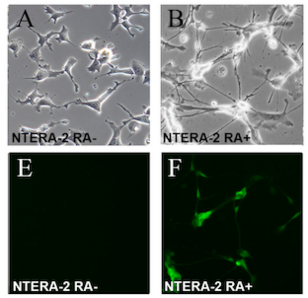Biology:NTERA-2
The NTERA-2 (also designated NTERA2/D1, NTERA2, or NT2) cell line is a clonally derived, pluripotent human embryonal carcinoma cell line.[1]
Characteristics
NTERA-2 cells exhibit biochemical and developmental properties similar to the cells of the early embryo, and can be used to study the early stages of human neurogenesis. The cells exhibit a high nucleo-cytoplasmic ratio, prominent nucleoli, and the expression of the glycolipid antigen SSEA-3. They also express nestin and vimentin, which are found in neuroepithelial precursor cells, as well as microtubule-associated proteins expressed in human neuroepithelium.[2] NTERA-2 cells also accumulate cytoplasmic glycogen.[3]
Differentiation
NTERA-2 cells differentiate when exposed to retinoic acid and lose expression of SSEA-3. Differentiation produces neurons via asymmetric cell division, and these cells form interconnected axon networks and express tetanus toxin receptors and neurofilament proteins.[4] By 10–14 days of exposure to retinoic acid, NTERA-2 cells begin to take on the morphological characteristics of neurons, such as rounded cell bodies and processes.[2] NTERA-2 cells can also produce a small number of oligodendrocyte-type cells, but they cannot differentiate into astrocytes.[5]
Research
Because of their similarity to human embryonic stem cells, NTERA-2 cells are used to study the dopaminergic differentiation of neuronal precursor cells.[6] They have also been proposed as an in vitro test system for developmental neurotoxicity.[7]
History
NTERA-2 cells were originally isolated from a lung metastasis from a 22-year-old male patient with primary embryonal carcinoma of the testis. The tumor was xenografted onto a mouse, and from this cells were cloned into the NTERA-2 cell line.[3]
References
- ↑ "Differentiation of NTERA-2 clonal human embryonal carcinoma cells into neurons involves the induction of all three neurofilament proteins.". J Neurosci 6 (2): 514–21. 1986. doi:10.1523/jneurosci.06-02-00514.1986. PMID 2419526.
- ↑ 2.0 2.1 "NTera 2 cells: a human cell line which displays characteristics expected of a human committed neuronal progenitor cell.". J Neurosci Res 35 (6): 585–602. 1993. doi:10.1002/jnr.490350603. PMID 8411264. https://pubmed.ncbi.nlm.nih.gov/8411264.
- ↑ 3.0 3.1 "Pluripotent embryonal carcinoma clones derived from the human teratocarcinoma cell line Tera-2. Differentiation in vivo and in vitro.". Lab Invest 50 (2): 147–62. 1984. PMID 6694356. https://pubmed.ncbi.nlm.nih.gov/6694356.
- ↑ Andrews PW (1984). "Retinoic acid induces neuronal differentiation of a cloned human embryonal carcinoma cell line in vitro.". Dev Biol 103 (2): 285–93. doi:10.1016/0012-1606(84)90316-6. PMID 6144603. https://pubmed.ncbi.nlm.nih.gov/6144603.
- ↑ "The human NTERA2 neural cell line generates neurons on growth under neural stem cell conditions and exhibits characteristics of radial glial cells.". Mol Cell Neurosci 24 (1): 198–213. 2003. doi:10.1016/s1044-7431(03)00161-1. PMID 14550780. https://pubmed.ncbi.nlm.nih.gov/14550780.
- ↑ "NTera2: a model system to study dopaminergic differentiation of human embryonic stem cells.". Stem Cells Dev 14 (5): 517–34. 2005. doi:10.1089/scd.2005.14.517. PMID 16305337. https://pubmed.ncbi.nlm.nih.gov/16305337.
- ↑ "Human Ntera2 cells as a predictive in vitro test system for developmental neurotoxicity.". Arch Toxicol 88 (1): 127–36. 2014. doi:10.1007/s00204-013-1098-1. PMID 23917397. https://pubmed.ncbi.nlm.nih.gov/23917397.
External links
 |


